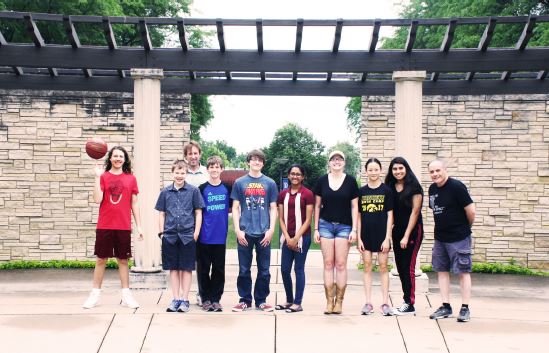by Katrina Sletten
The Drake physics department welcomed 10 high school students from the surrounding Des Moines area to get a taste of college level astrophysics this summer. The program ran for two weeks, where campers came to the Drake campus for a few hours a day, visiting occassionally the Drake Municipal Observatory.
The main focus of the camp was to engage students in astronomy and physics through hands-on activities in a fun, collaborative environment. During the initial phase of the camp, the students were introduced to the necessary content needed to complete the research-based project; calculating the Hubble constant and age of the universe.
The camp was led by Drake’s Associate Professor of Astronomy and Astrophysics Dr. Charles Nelson, and assisted by Herb Folsom, adjunct instructor of astronomy who helped with laboratory activities.
The camp began in the 1970’s and lasted for a number of years, but was eventually put on hold due to lack of funding. It was resurrected this past year with the help of Drake alumni James Holsapple, who is now chairman of the department of neurosurgery and program director of neurological surgery at Boston General Hospital.
The department will continue to host the camp for at least two more years, and is continuing to search for more donor support so the camp can grow.
The project that the students worked toward was an adapted, sophomore-level astrophysics lab where students use Cepheid variables to find the Hubble constant and the age of the universe.
The first step of the project for the campers was to look at light curves for Cepheid variable stars, and measure the periods of rotation. Once that was complete, they figured out the period-luminosity relation. The students came up with their own trend line for period-luminosity relation, and then applied it to Cepheid galaxies in M100, where they were then able to figure out the Hubble constant. In the end, the campers created a research poster to document the work completed and their findings.
PHYSICS CAMP 2017 From left to right, Rocky Vizcarra, Reece Riley, Charlie Nelson, Matthew Gerling, Chase Johnston, Rabsa Naseer, Madelyn Klinkefus, Kristin He, Katie Aguayo, Herb Folsom.
The instructors employed other activities to engage the students in new and enjoyable ways, such as watching the movie Contact, investigating the science behind boomerangs by playing with them, and observing line spectra.
“We want to attract students to physics and to our department specifically, but of course the usefulness goes beyond that,” Dr. Athanasios Petridis said, chair of the department of physics and astronomy. “I think it is very important for high school and middle school students to be exposed to science as much as possible within their courses and outside of their courses to develop some interest and manage to maintain their curiosity. Because the data shows that curiosity of students dwindles as they become older. Maybe that is because of the way we teach science in high schools. So we are trying to counteract that.”
Overall, the camp successfully provided an atmosphere for the students to get excited about science through a mix of research experience and fun science-related activities. According to Nelson, it is important to engage students during the summer, to keep their minds fresh and to make sure science is fun, both of which this camp achieved.
“We can explore something cool like the expansion of the universe in a fun setting that doesn’t have grades associated with it, and so all the pressure comes off and its all about having fun with science, and what could be more beneficial than that?”


